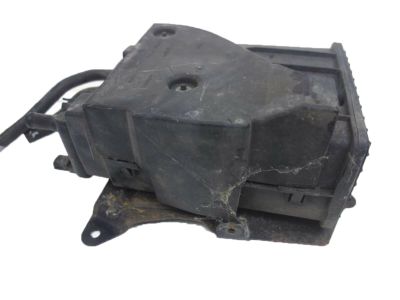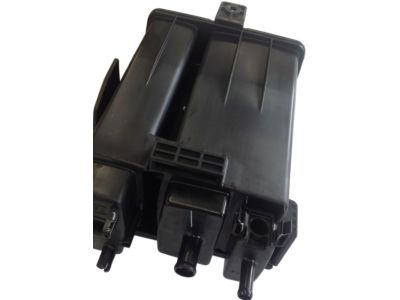×
- Live Chat
- 1-888-726-6993

My Garage
My Account
Cart
Genuine Nissan 350Z Vapor Canister
Fuel Vapor Canister- Select Vehicle by Model
- Select Vehicle by VIN
Select Vehicle by Model
orMake
Model
Year
Select Vehicle by VIN
For the most accurate results, select vehicle by your VIN (Vehicle Identification Number).
2 Vapor Canisters found
Nissan 350Z CANISTER Assembly-EVAPORATION
Part Number: 14950-CD000$196.29 MSRP: $270.37You Save: $74.08 (28%)Nissan 350Z CANISTER Assembly E
Part Number: 14950-CD00A$196.29 MSRP: $270.37You Save: $74.08 (28%)Ships in 1-3 Business Days
Nissan 350Z Vapor Canister
If you need any OEM Nissan 350Z Vapor Canister, feel free to choose them out of our huge selection of genuine Nissan 350Z Vapor Canister. All our parts are offered at unbeatable prices and are supported by the manufacturer's warranty. In addition, we offer quick shipping to have your parts delivered to your door step in a matter of days.
Nissan 350Z Vapor Canister Parts Questions & Experts Answers
- Q: How do you identify the symptoms of a faulty Canister Purge Valve, Vapor Canister, or Vapor Pressure Sensor in the EVAP system on Nissan 350Z?A: The Evaporative Emissions Control (EVAP) system prevents fuel system vapors from escaping into the atmosphere. On hot days, fumes confined inside the gas tank expand and are sent through the fuel vapor vent valve and the fuel vapor control valve to the EVAP canister, where they're stored temporarily until they can be consumed by the engine during normal operation. The EVAP canister, which consists of activated carbon, is situated in the right rear corner of the automobile at a spot above the right rear wheel. The EVAP control system pressure sensor keeps an eye on evaporative gases pressure within purge line leading to intake manifold. The EVAP canister vent control valve is a solenoid that is only employed for diagnostic purposes of a faulty EVAP system and normally stays open. The EVAP canister purge solenoid is used to purge evaporative emissions from EVAP canister to intake manifold under PCM command. The strongest indication of an improper functioning or faulty EVAP system is an odor of heavy fuel. In case there is some odor of gasoline when driving or leaving after switching off ignition, begin with checking a tightness of a cap on a filler tube for gasoline storage. Low idle speed, stalling, cutting out and other drivability problems may be caused by defective fuel vapor vent valve or damaged hoses connected wrongly to wrong tubes. Fuel lost or smell might mean that there will be leaking from fuel lines or hoses, cracked or damaged carbon canisters as well as failure of vapor valves in these cases like this one shown below. The location for the U.S.A Evap Can Purge Sol Right Rear Engine Compartment mounted on small bracket next to Rt Strut Tower And Right Rear Wheel Well Above Small Splash Shield/Evap Can Vent Ctrl Valve/Evap Cont Sys prsSens Assembly being behind Rr Whl Wl Abv Sm Sshld.' Evaporative Emissions Control (EVAP) system prevents the vapor of fuel from escaping into the atmosphere. On hot days, fumes are trapped in the fuel tank and expand as they are directed through a fuel vapour vent valve and a fuel vapour control valve into the EVAP canister where they stay temporarily until being consumed by the engine during normal operation. In vehicles, activated charcoal is used to form an EVAP canister, which is typically located in the right rear corner above the right rear wheel. The EVAP canister pressure sensor monitors pressure in evaporative gases within purge line leading to intake manifold. The EVAP canister vent control valve is normally open and used only for diagnosis of the EVAP system. For this reason it usually stays open unless it is closed by computerized PCM actuation during brief testing purposes thus indicating that there is no fault with EVAP system that may be identified using this solenoid behaviour.. The PCM controls an electrical solenoid that opens or closes a vacuum line from the intake manifold to the purge valve during various engine running conditions. The strong smell of petrol, on warm days while driving or immediately after parking and switching off engine should first direct attention to whether petrol cap was tightly applied back again.Evaporative Emissions Control (EVAP) system prevents gasoline fumes from escaping into atmosphere. If you notice any smell of gasoline when driving or after turning off your vehicle, check first if your cap in tightness on a fill tube for gas storage.If one smells gas while driving or after parking and stopping engine, initial investigation should begin with checking whether gas cap was properly closed.Warm day gasoline odors while one drives or even just as he/she parks and turns off his/her car should make him/her check whether a gas filler cap is properly sealed.The undelivered or stinking fuel means there could be leakage between hoses/lines with respect to gas lines/hoses, a damaged or cracked canister, as well as broken vapor valves.The EVAP canister purge solenoid is on the right rear part of the engine compartment on a small bracket at the right strut tower. D. Look for an Evap Can Purge Sol Right Rear Engine Compartment (Rt Strut Tower) And Right Rear Wheel Well Above Small Splash Shield/Evap Can Vent Ctrl Valve/Evap Cont Sys prsSens Assembly being behind Rr Whl Wl Abv Sm Sshld.The oxygen sensor(s), fuel injectors, and spark plugs are located within the air/fuel mixture exhaust system.See that EVAP Can Vent Ctrl Valve is found at the can itself. A faulty Fuel Vapor Vent Valve or Canister Purge Solenoid could also cause poor idle, stalling, and poor drivability resulting from incorrect hoses connections to wrong tubes.This could mean fuel loss or has smell because of deficient vapor valve, split hose or tank damage.Therefore, this indicates that there may be cracked or damaged carbon canisters whereby fuel odour or leakage will occur. The EVAP purge solenoid valve is located in the right rear corner of the engine compartment on a small bracket attached to the right strut tower. Thus, EVAP Can/EVAP Can Vent Ctrl Valve/EVAP Cont Sys prsSens Assm being positioned behind Rr Whl Wl Abv Sm Sshld.








